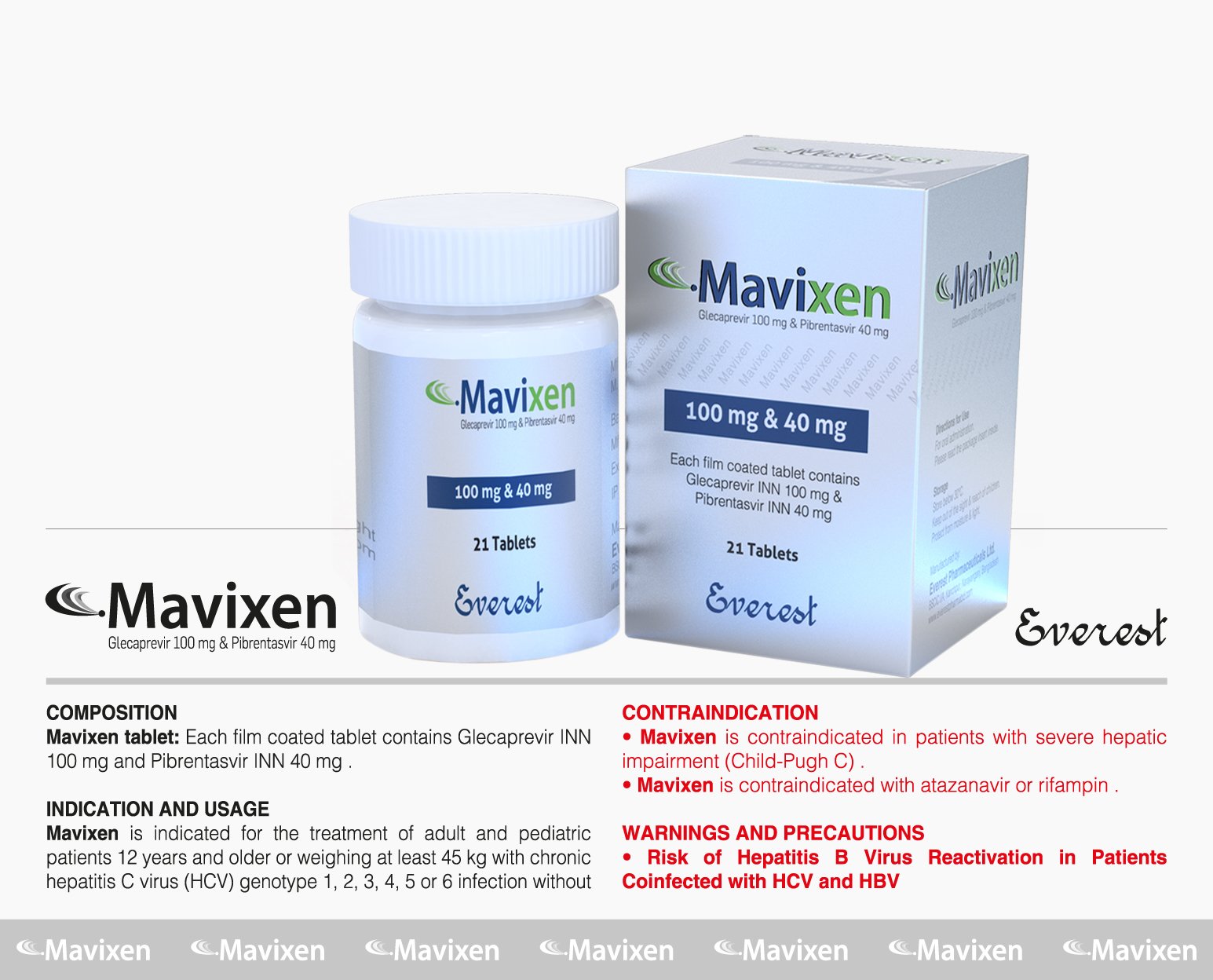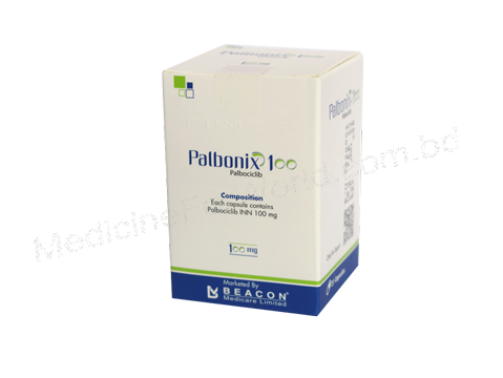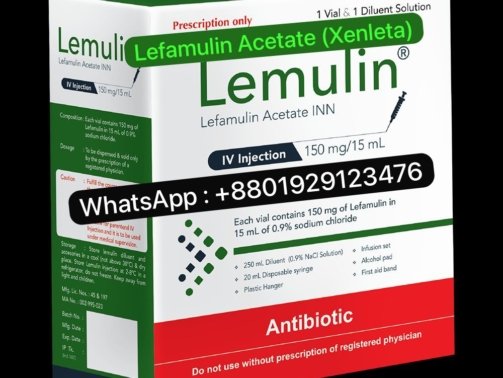Glecaprevir 100 mg/Pibrentasvir 40 mg
0.00$
Mavixen, a combination therapy of Glecaprevir and Pibrentasvir, is used to treat chronic hepatitis C virus (HCV) infection in adults, including those with HIV-1 coinfection. By inhibiting specific viral proteins, Mavixen disrupts viral replication. It’s administered orally once daily with food, with treatment duration and dosage tailored to individual patient characteristics. While generally well-tolerated, monitoring for potential side effects such as liver abnormalities and bradycardia is advised. In case of overdose, supportive care is recommended, and patients should consult healthcare providers for tailored guidance.
Glaceprevir and Pibrentasvir are two antiviral drugs in tablet combination with solid doses for the treatment of chronic hepatitis virus (HCV) infections in 3-year-old adults and pediatric patients. Brand names such as Mavoutet sell this combination. This became the first line option due to its pan-xenotype activity, short duration of treatment and high cure rates.
Components and mechanisms of action
Glaceprevir is an NS3/4A -Pototeeaas-inhibitor. Block proteins that replicate the necessary viruses. Without this protein, the hepatitis virus cannot process its replication in the liver to mature and block it.
Pibrentasvir is an NS5A inhibitor. Pibrentasvir blocks different proteins that are critical to viral replication and assembly. Block viral RNA replication and viral assembly in liver cells.
Together, these drugs have several steps in the life cycle of the hepatitis-C virus and affect all six major genotypes (1 6). This broad spectrum activity allows clinicians to administer the same drug regardless of viral genotype, simplifying treatment plans and improving access to treatment.
Adaptation and use
Glaceprevir/Pibrentasvir is approved for the treatment of chronic HCV infection in patients.
Cirrhosis is either missing or present in child A with compensated encephalopathy.
1, 2, 3, 4, 5, or 6 genotypes.
People who have been able to receive previous treatment with another HCV therapy.
It also contains either NS5A inhibitors or NS3/4A protease inhibitors, but not both, and was previously used in patients with chronic HCV genotype 1-disease. Dosage and administration
The usual adult dose is 3 tablets with food for 8-12 weeks daily, depending on the patient’s treatment analysis and the presence or deficiency of cirrhosis. In children weighing at least 12 kg, the dose is based on weight.
Do not crush or bite the tablets. Daily hospitalizations are transmitted simultaneously to achieve stable blood concentrations of medication.
Clinical studies have shown an SVR rate of >95%, indicating that most patients who received this combination have been cured. Twelve weeks following treatment, SVR is still identifiable as an undetectable HCV-RNA thus is regarded as a clinical cure for infection.
Side effects
Most patients are well tolerated by medication. Side effects include:
headache
Fatigue
trimming
diarrhea
insomnia
Severe side effects are rare, but increased liver enzymes can be included, especially in patients with advanced liver disease or co-infection with hepatitis B virus (HBV). In some cases, screening for hepatitis B is recommended prior to treatment, as HBV reactivation is occurring.
Warnings and Precautions
Avoid using Pew B or C in children who have severe liver disease. Risk of drug interaction: Both Glaceprevir and Pibrentasvir are metabolized by the liver and can be expected to interact with a variety of drugs, anti-epileptic, antiretroviruses, statins, and more.
Pregnant and breastfeeding women should consult with their treatment physician as data is limited for pregnancy and breastfeeding.
Storage and availability
Tablets must be avoided at room temperature, heat and moisture. Glaceprevir/Pibrentasvir is subject to prescription and can be made available to legal patients through special pharmacies or patient assistance programs.
Conclusion
Glaceprevir 100 mg/Pibrentasvir 40 mg is a highly effective and well-accepted oral medication that offers an optimized approach to the treatment of hepatitis C. The effectiveness of the pan-type form and short treatment periods have revolutionized the treatment of HCV and provide hope for the elimination of the disease as a threat to public health.
Order Now At Mdx Pharma bd….
To order from MDX Pharma BD, visit their website at https://mdxpharmabd.com, where you can browse products and place orders online. For inquiries or orders via email, contact emedicarepharma@gmail.com. Alternatively, call (+88) 01929123476. Their address is 29, Abdullahpur, Uttara, Dhaka-1230, Bangladesh.
1. How does Glaceprevir/Pibrentasvir work in the treatment of hepatitis C?
Glaceprevir/Pibrentasvir blocks essential hepatitis-C viral proteins, NS3/4A proteases and NS5a to prevent viral replication and spread of infection. It effectively keeps the virus growing in the body.
2. Which HCV genotypes are effective in glaceprevir/pibrentasvir?
Glaceprevir/Pibrentasvir acts on all six major hepatitis virus genotypes (1 6). This creates a bold treatment option for chronic HCV infection regardless of genotype. What is the standard treatment period for this combination? The standard treatment period is usually 8 weeks for most patients who received treatment without cirrhosis. Some patients, such as pretreatment patients, may require 12 weeks.
3. What should a patient do if the dose is missed?
If the dose is missed, use immediately as a reminder, unless it is almost the time of the next dose. Do not double the dose. Continue with your schedule.
4. Do liver function need to be monitored during treatment?
Yes, liver function should be monitored during treatment to determine the adverse effects or deterioration of liver function, particularly in patients with pre-existing liver disease or signs of decompensation.
5. Are you sure to use it during pregnancy or breastfeeding?
Glaceprevir/Pibrentasvir has limited safety data during pregnancy and breastfeeding. Usually not recommended unless obviously needed. Risks and benefits should be discussed with your healthcare service provider.
6. Do patients with liver damage need to adjust doses?
Dose adjustment is not required for minor liver damage. However, due to toxicity risk, Glaceprevir/Pibrentasvir is contraindicated in patients with moderate to severe liver damage (Pu B or C in children).
| Product Name | Mavixen |
|---|---|
| Generic Name | Glecaprevir /Pibrentasvir |
| Formulation | Tablet |
| Available Pack Size | 21 Tablets |
| Available Strength | 100 mg & 40 mg |

 Cart is empty
Cart is empty 



